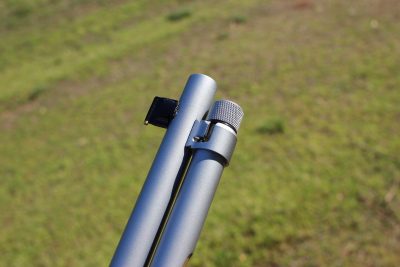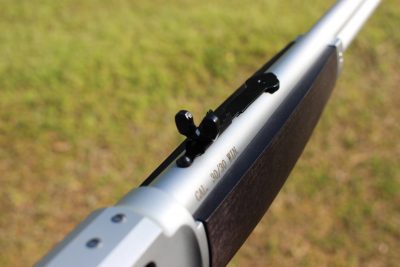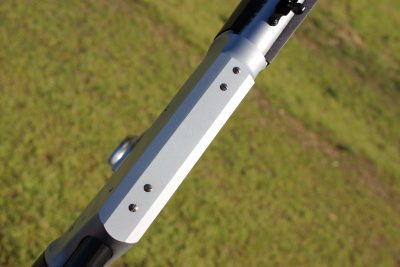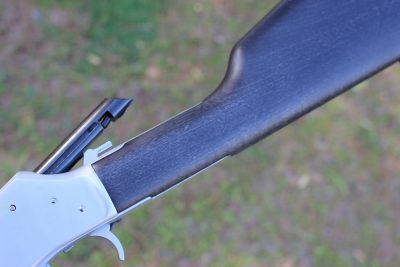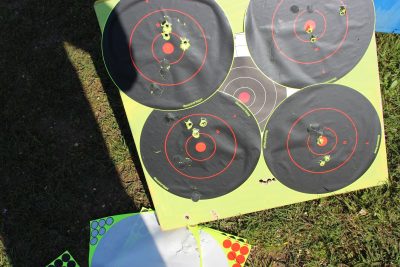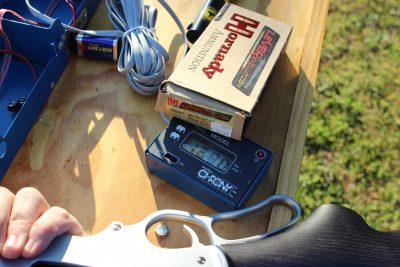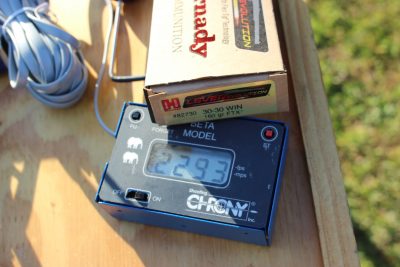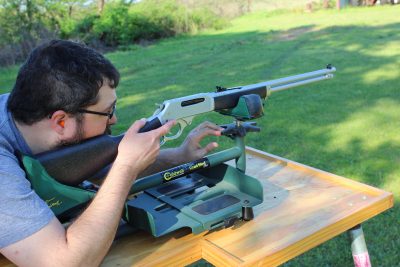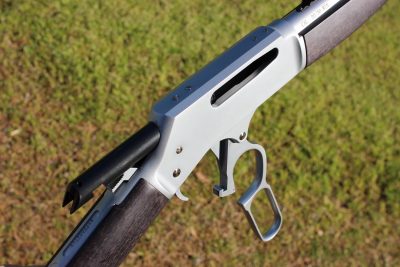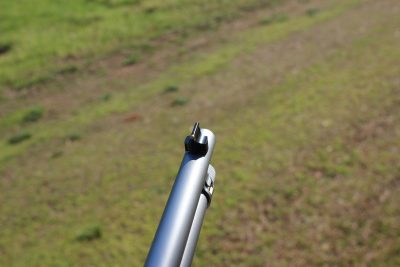For more information, visit https://www.henryusa.com/rifles/all-weather-lever-action/.
To purchase a Henry All-Weather lever-action on GunsAmerica.com, click this link: https://www.gunsamerica.com/Search.aspx?T=henry%20all%20weather.
Henry Repeating Arms takes its name from the inventor of the first reliable repeating rifle, Benjamin Tyler Henry. That took place back in 1860—when most rifles were still loaded from the muzzle end. In 1996 the Henry name was revived and the brass framed lever guns were once again available. Made in America, too. That’s a big point of pride for Henry.
A big chunk of the Henry portfolio is in rimfire and pistol-caliber rifles and carbines. It was only within the last handful of years that Henry started to make some full powered rifles, which they call the “Large Caliber Rifles”. These rifles, like pretty much all of the Henry offerings, are downright handsome. We are talking classic-styled rifles with Walnut stocks, deep rich bluing on the steel and of course the traditional Henry brass frame. They are sexy-looking long guns that make it hard not to treat them as safe queens. But these are rifles that can be great field, truck or saddle guns. Henry now has the perfect compromise with the All-Weather Lever Actions that are available in 30-30 and 45-70 and are designed to stand up to the elements while still delivering the full Henry rifle experience.
All-Weather?
So what makes this an All-Weather rifle? At first glance these look to be matte finished stainless rifles, but they are not. The receiver, barrel and most other parts on these rifles are hard chromed. Really, the whole rifle sports the coating except the bolt, springs and sights. The hard chrome looks nothing like the super shiny stuff that we dress cars up with. It is harder, thicker and more resistant to corrosion, which is exactly why Henry chose this treatment for these guns. The stocks on these rifles are hardwood with what feels like a thick polymer coating. Although not as visually striking as some other Henry Rifles, the contrast of the silver and black does make for a good looking gun.
A Henry is a Henry
There are a couple of things that make a Henry, well, a Henry. One is the side ejection found on all models, excluding the reproduction of the original Henry design (the one from the 1860s). The other is the way they load. All of the Henrys load from the muzzle end of the tubular magazine. A spring loaded brass tube that rides inside the magazine keeps the rounds in place and pushed to the rear for feeding. This is a take on the way the original Henry loaded. This is not the more common loading gate on the side of the receiver that Winchester and Marlin use. Using the loading tube sometimes takes a little work and getting used to. You remove the magazine tube spring system from the tubular magazine, drop in the rounds from the end of the magazine tube, and then have to wiggle the magazine tube spring system around and twist as you push it closed to clear the case rims.
Henry sent me two rifles for this review—one in 30-30 and the other in .45-70. Other than caliber and stock grip, these rifles are almost identical.
Specifications
Henry All-Weather .30-30
-
Model Number: H009AW
- Action Type: Lever-action
- Caliber: .30-30
- Capacity: 5 rounds
- Length: 39 inches
- Barrel Length: 20 inches
- Weight: 7 pounds
- Stock: Straight-grip hardwood with rubber buttpad and black coating
- Sights: Fully adjustable semi-buckhorn rear, and brass beaded front sight
- Finish: Hard chrome
- MSRP: $999.95
All-Weather .45-70
- The tops of both rifles’ receivers are drilled and tapped on both rifles.
- Model Number: H010AW
- Action Type: Lever-action
- Caliber: .45-70
- Capacity: 4 rounds
- Length: 39 inches
- Barrel Length: 18.43 inches
- Weight: 7.08 pounds
- Stock: Pistol grip hardwood with rubber buttpad and black coating
- Sights: Fully adjustable semi-buckhorn rear, and brass beaded front sight
- MSRP: $999.95
Fit and Finish
Both of the review rifles have a very nice fit to all parts. The transition from the stock to the receiver is smooth and tight and so is the forend. The finish on the stocks is more matte than gloss but is still pretty slick. One thing I think would help these rifles is a bit of grip texture. During a cold and rainy hunt, gloved hands might be a little slippery.
The action is pretty slick out of the box and got smoother the more it was cycled. This is not as smooth as a tricked-out Cowboy Action lever gun, but this is not meant for competition. This is a working gun—a gun that wants to ride around in the truck, or in a handlebar rack on an ATV. Like a good dog, this gun needs to work.
The Henry All-Weather rifles come set up with the classic lever gun sights—semi-buckhorn rear with a brass front bead. If you want to add an optic Henry has you covered. The top of the receiver is drilled and tapped to take a Weaver 63B mount.
Shooting
.30-30
I love shooting .30-30 lever guns. It might be due to the fact that it was the first centerfire rifle I ever shot but I think it has more to do with it being a great “medium” round. This is a medium range, medium power, medium recoil and medium game rifle. There have probably been more whitetail deer taken with a lever action .30-30 at or under 100 yards than with any other gun or cartridge.
This Henry All-Weather in .30-30 is more than capable of carrying on that tradition. Out of the box the review gun was shooting a bit low. I made a slight adjustment to the rear sight that quickly brought the gun on target. I ran Hornady LEVERevelution 160 grain through the Henry, along with a random smattering of extras we had (including a couple of boxes of Winchesters). All worked predictably well. There are so many varieties of .30-30 available, and almost every sporting goods store and big-box retailer in the country should have a decent selection. From the sled on my portable bench I was able to get 1 MOA out of the Hornady, and the Winchester 150 grain Super-X Softpoints opened up a bit but only by about a quarter inch.
.45-70
The .45-70 is of course a bigger and harder hitting round. With the right load and within reasonable distance, there isn’t anything in North American you couldn’t take with this round. Hell, there isn’t really anything in the world short of large African dangerous game that would be too much for a .45-70. 300 grains moving at close to 2,000 feet per second hits hard, and with the Henry you have five of them that can be fired in seconds.
Range results from the review .45-70 are exactly like I expected. If I did my part, three rounds inside an inch from 100 yards were done with ease and consistency. The 325 grain Hornady LEVERevelution preformed, as well as some Super X Winchester 300 grain. The Henry All-Weather .45-70 is true to form on what a lever gun chambered in this round should be—hard hitting and reliable.
Reliability is why this platform continues to remain relevant. The lever gun is capable under ridiculous conditions. As long as you are still functioning, it will function. It is the height of mid 19th century tactical design that is still useful today.
Made in the USA
I want to take a few words to talk about the “Made in The USA” aspect of the brand. If you are one who tracks trends in the firearms industry, pay attention to patriotism. My bet is that “Made in America” is about to become wildly fashionable. Henry isn’t going to have to remind you they make their guns in the States—it has been such a core part of the company’s identity. If you want a newly manufactured American-made lever action rifle, Henry should be on your short list. But there is more to them that just being made in The States—they are solid and reliable firearms.
Maybe Henry should do a play off of Trump’s Make America Great slogan?
Final Thoughts
These are two very capable rifles in two of the must iconic American hunting calibers. If you are looking for a great whitetail hunting rifle you could do a lot worse than the Henry .30-30. Need a rifle for the bigger game? The .45-70 will do the trick. It would also make a great bear country defense rifle as well. Add all of that in with the All-Weather nature of these guns and we have a winner of a pack, truck or general backcountry rifle.
For more information, visit https://www.henryusa.com/rifles/all-weather-lever-action/.
To purchase a Henry All-Weather lever-action on GunsAmerica.com, click this link: https://www.gunsamerica.com/Search.aspx?T=henry%20all%20weather.
[one_half]
[/one_half][one_half_last]
[/one_half_last][one_half]
[/one_half][one_half_last]
[/one_half_last]

